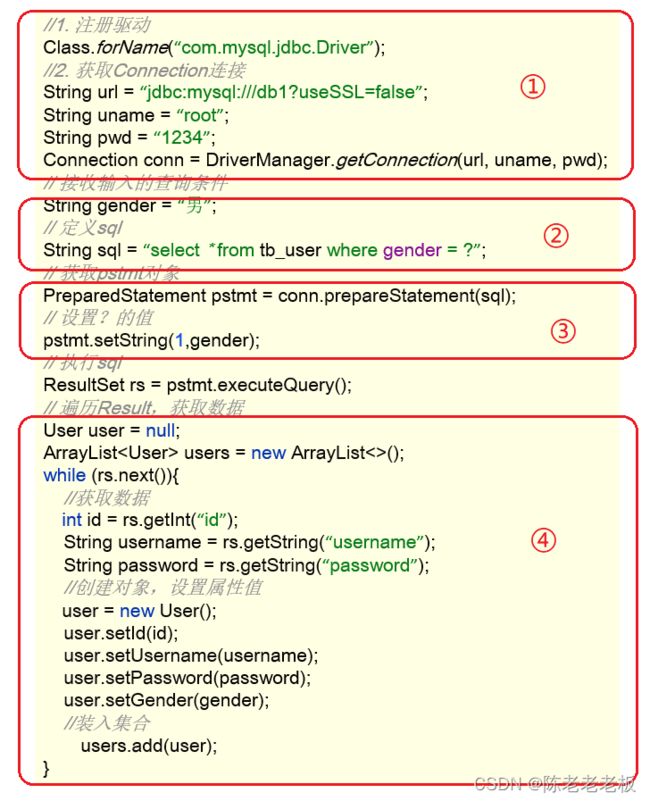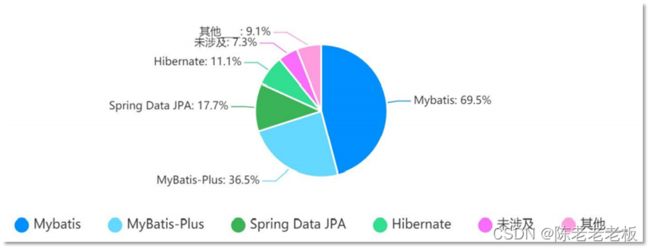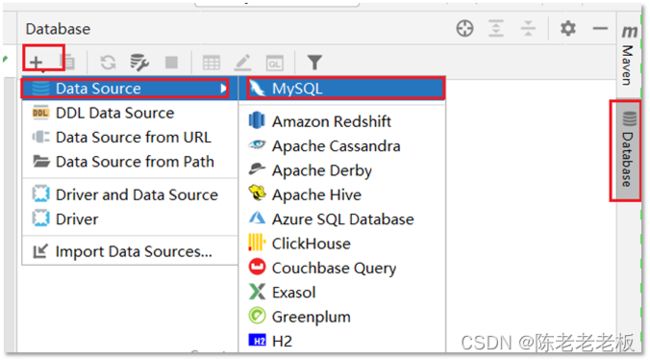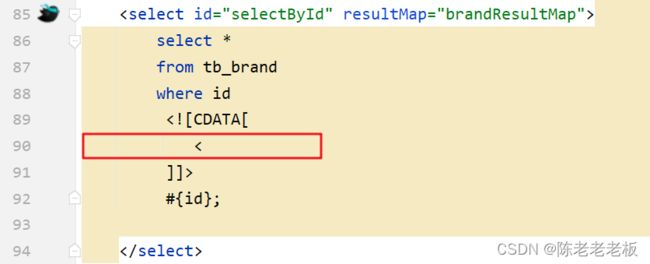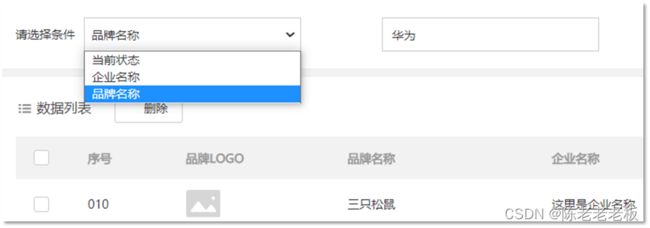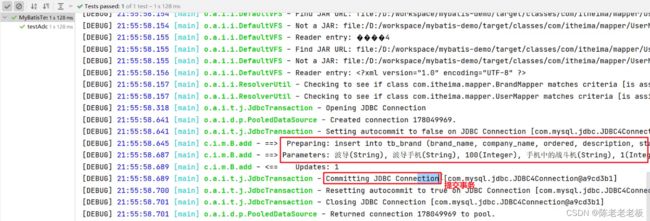《JavaWeb篇》04.Mybatis看这一篇就够了
一、Mybatis
陈老老老板 说明:在整体的复习一遍知识,边复习边总结,基础真的重要,需要注意的地方>都标红了,还有资源的分享. 一起加油。
视频链接:黑马视频链接
资源分享:Mybatis资源
1. Mybatis概述
1.1 Mybatis概念
MyBatis 是一款优秀的持久层框架,用于简化 JDBC 开发
MyBatis 本是 Apache 的一个开源项目iBatis, 2010年这个项目由apache software foundation 迁移到了google code,并且改名为MyBatis 。2013年11月迁移到Github
官网:https://mybatis.org/mybatis-3/zh/index.html
持久层:
-
负责将数据到保存到数据库的那一层代码。
以后开发我们会将操作数据库的Java代码作为持久层。而Mybatis就是对jdbc代码进行了封装。
-
JavaEE三层架构:表现层、业务层、持久层
框架:
- 框架就是一个半成品软件,是一套可重用的、通用的、软件基础代码模型
- 在框架的基础之上构建软件编写更加高效、规范、通用、可扩展
了解了什么是Mybatis后,接下来说说以前 JDBC代码 的缺点以及Mybatis又是如何解决的。
1.2 JDBC 缺点
下面是 JDBC 代码,我们通过该代码分析都存在什么缺点:
-
硬编码
-
注册驱动、获取连接
上图标1的代码有很多字符串,而这些是连接数据库的四个基本信息,以后如果要将Mysql数据库换成其他的关系型数据库的话,这四个地方都需要修改,如果放在此处就意味着要修改我们的源代码。
-
SQL语句
上图标2的代码。如果表结构发生变化,SQL语句就要进行更改。这也不方便后期的维护。
-
-
操作繁琐
-
手动设置参数
-
手动封装结果集
上图标4的代码是对查询到的数据进行封装,而这部分代码是没有什么技术含量,而且特别耗费时间的。
-
1.3 Mybatis 优化
- 硬编码可以配置到配置文件
- 操作繁琐的地方mybatis都自动完成
如图所示
下图是持久层框架的使用占比。
2 Mybatis快速入门
需求:查询user表中所有的数据
-
创建user表,添加数据
create database mybatis; use mybatis; drop table if exists tb_user; create table tb_user( id int primary key auto_increment, username varchar(20), password varchar(20), gender char(1), addr varchar(30) ); INSERT INTO tb_user VALUES (1, 'zhangsan', '123', '男', '北京'); INSERT INTO tb_user VALUES (2, '李四', '234', '女', '天津'); INSERT INTO tb_user VALUES (3, '王五', '11', '男', '西安'); -
创建模块,导入坐标
在创建好的模块中的 pom.xml 配置文件中添加依赖的坐标
<dependencies> <dependency> <groupId>org.mybatisgroupId> <artifactId>mybatisartifactId> <version>3.5.5version> dependency> <dependency> <groupId>mysqlgroupId> <artifactId>mysql-connector-javaartifactId> <version>5.1.46version> dependency> <dependency> <groupId>junitgroupId> <artifactId>junitartifactId> <version>4.13version> <scope>testscope> dependency> <dependency> <groupId>org.slf4jgroupId> <artifactId>slf4j-apiartifactId> <version>1.7.20version> dependency> <dependency> <groupId>ch.qos.logbackgroupId> <artifactId>logback-classicartifactId> <version>1.2.3version> dependency> <dependency> <groupId>ch.qos.logbackgroupId> <artifactId>logback-coreartifactId> <version>1.2.3version> dependency> dependencies>注意:需要在项目的 resources 目录下创建logback的配置文件
-
编写 MyBatis 核心配置文件 – > 替换连接信息 解决硬编码问题
在模块下的 resources 目录下创建mybatis的配置文件
mybatis-config.xml,内容如下:DOCTYPE configuration PUBLIC "-//mybatis.org//DTD Config 3.0//EN" "http://mybatis.org/dtd/mybatis-3-config.dtd"> <configuration> <typeAliases> <package name="com.itheima.pojo"/> typeAliases> <environments default="development"> <environment id="development"> <transactionManager type="JDBC"/> <dataSource type="POOLED"> <property name="driver" value="com.mysql.jdbc.Driver"/> <property name="url" value="jdbc:mysql:///mybatis?useSSL=false"/> <property name="username" value="root"/> <property name="password" value="1234"/> dataSource> environment> <environment id="test"> <transactionManager type="JDBC"/> <dataSource type="POOLED"> <property name="driver" value="com.mysql.jdbc.Driver"/> <property name="url" value="jdbc:mysql:///mybatis?useSSL=false"/> <property name="username" value="root"/> <property name="password" value="1234"/> dataSource> environment> environments> <mappers> <mapper resource="UserMapper.xml"/> mappers> configuration> -
编写 SQL 映射文件 --> 统一管理sql语句,解决硬编码问题
在模块的
resources目录下创建映射配置文件UserMapper.xml,内容如下:DOCTYPE mapper PUBLIC "-//mybatis.org//DTD Mapper 3.0//EN" "http://mybatis.org/dtd/mybatis-3-mapper.dtd"> <mapper namespace="test"> <select id="selectAll" resultType="com.itheima.pojo.User"> select * from tb_user; select> mapper> -
编码
-
在
com.itheima.pojo包下创建 User类public class User { private int id; private String username; private String password; private String gender; private String addr; //省略了 setter 和 getter } -
在
com.itheima包下编写 MybatisDemo 测试类public class MyBatisDemo { public static void main(String[] args) throws IOException { //1. 加载mybatis的核心配置文件,获取 SqlSessionFactory String resource = "mybatis-config.xml"; InputStream inputStream = Resources.getResourceAsStream(resource); SqlSessionFactory sqlSessionFactory = new SqlSessionFactoryBuilder().build(inputStream); //2. 获取SqlSession对象,用它来执行sql SqlSession sqlSession = sqlSessionFactory.openSession(); //3. 执行sql List<User> users = sqlSession.selectList("test.selectAll"); //参数是一个字符串,该字符串必须是映射配置文件的namespace.id System.out.println(users); //4. 释放资源 sqlSession.close(); } }
-
解决SQL映射文件的警告提示:
在入门案例映射配置文件中存在报红的情况。问题如下:
- 产生的原因:Idea和数据库没有建立连接,不识别表信息。但是大家一定要记住,它并不影响程序的执行。
- 解决方式:在Idea中配置MySQL数据库连接。
IDEA中配置MySQL数据库连接
-
点击IDEA右边框的
Database,在展开的界面点击+选择Data Source,再选择MySQL -
在弹出的界面进行基本信息的填写
-
点击完成后就能看到如下界面
而此界面就和
navicat工具一样可以进行数据库的操作。也可以编写SQL语句
3 Mapper代理开发
3.1 Mapper代理开发概述
之前我们写的代码是基本使用方式,它也存在硬编码的问题,如下:
这里调用 selectList() 方法传递的参数是映射配置文件中的 namespace.id值。这样写也不便于后期的维护。如果使用 Mapper 代理方式(如下图)则不存在硬编码问题。
通过上面的描述可以看出 Mapper 代理方式的目的:
- 解决原生方式中的硬编码
- 简化后期执行SQL
Mybatis 官网也是推荐使用 Mapper 代理的方式。下图是截止官网的图片
3.2 使用Mapper代理要求
使用Mapper代理方式,必须满足以下要求:
-
定义与SQL映射文件同名的Mapper接口,并且将Mapper接口和SQL映射文件放置在同一目录下。如下图:
-
设置SQL映射文件的namespace属性为Mapper接口全限定名
-
在 Mapper 接口中定义方法,方法名就是SQL映射文件中sql语句的id,并保持参数类型和返回值类型一致
3.3 案例代码实现
-
在
com.itheima.mapper包下创建 UserMapper接口,代码如下:public interface UserMapper { List<User> selectAll(); User selectById(int id); } -
在
resources下创建com/itheima/mapper目录,并在该目录下创建 UserMapper.xml 映射配置文件<mapper namespace="com.itheima.mapper.UserMapper"> <select id="selectAll" resultType="com.itheima.pojo.User"> select * from tb_user; select> mapper> -
在
com.itheima包下创建 MybatisDemo2 测试类,代码如下:/** * Mybatis 代理开发 */ public class MyBatisDemo2 { public static void main(String[] args) throws IOException { //1. 加载mybatis的核心配置文件,获取 SqlSessionFactory String resource = "mybatis-config.xml"; InputStream inputStream = Resources.getResourceAsStream(resource); SqlSessionFactory sqlSessionFactory = new SqlSessionFactoryBuilder().build(inputStream); //2. 获取SqlSession对象,用它来执行sql SqlSession sqlSession = sqlSessionFactory.openSession(); //3. 执行sql //3.1 获取UserMapper接口的代理对象 UserMapper userMapper = sqlSession.getMapper(UserMapper.class); List<User> users = userMapper.selectAll(); System.out.println(users); //4. 释放资源 sqlSession.close(); } }
注意:
如果Mapper接口名称和SQL映射文件名称相同,并在同一目录下,则可以使用包扫描的方式简化SQL映射文件的加载。也就是将核心配置文件的加载映射配置文件的配置修改为
<mappers>
<package name="com.itheima.mapper"/>
mappers>
4. 核心配置文件
核心配置文件中现有的配置之前已经给大家进行了解释,而核心配置文件中还可以配置很多内容。我们可以通过查询官网看可以配置的内容
接下来我们先对里面的一些配置进行讲解。
4.1 多环境配置
在核心配置文件的 environments 标签中其实是可以配置多个 environment ,使用 id 给每段环境起名,在 environments 中使用 default='环境id' 来指定使用哪儿段配置。我们一般就配置一个 environment 即可。
<environments default="development">
<environment id="development">
<transactionManager type="JDBC"/>
<dataSource type="POOLED">
<property name="driver" value="com.mysql.jdbc.Driver"/>
<property name="url" value="jdbc:mysql:///mybatis?useSSL=false"/>
<property name="username" value="root"/>
<property name="password" value="1234"/>
dataSource>
environment>
<environment id="test">
<transactionManager type="JDBC"/>
<dataSource type="POOLED">
<property name="driver" value="com.mysql.jdbc.Driver"/>
<property name="url" value="jdbc:mysql:///mybatis?useSSL=false"/>
<property name="username" value="root"/>
<property name="password" value="1234"/>
dataSource>
environment>
environments>=
4.2 类型别名
在映射配置文件中的 resultType 属性需要配置数据封装的类型(类的全限定名)。而每次这样写是特别麻烦的,Mybatis 提供了 类型别名(typeAliases) 可以简化这部分的书写。
首先需要现在核心配置文件中配置类型别名,也就意味着给pojo包下所有的类起了别名(别名就是类名),不区分大小写。内容如下:
<typeAliases>
<package name="com.itheima.pojo"/>
typeAliases>
通过上述的配置,我们就可以简化映射配置文件中 resultType 属性值的编写
<mapper namespace="com.itheima.mapper.UserMapper">
<select id="selectAll" resultType="user">
select * from tb_user;
select>
mapper>
二、Mybatis练习
目标
- 能够使用映射配置文件实现CRUD操作
- 能够使用注解实现CRUD操作
1,配置文件实现CRUD
如上图所示产品原型,里面包含了品牌数据的 查询 、按条件查询、添加、删除、批量删除、修改 等功能,而这些功能其实就是对数据库表中的数据进行CRUD操作。接下来我们就使用Mybatis完成品牌数据的增删改查操作。以下是我们要完成功能列表:
- 查询
- 查询所有数据
- 查询详情
- 条件查询
- 添加
- 修改
- 修改全部字段
- 修改动态字段
- 删除
- 删除一个
- 批量删除
我们先将必要的环境准备一下。
1.1 环境准备
-
数据库表(tb_brand)及数据准备
-- 删除tb_brand表 drop table if exists tb_brand; -- 创建tb_brand表 create table tb_brand ( -- id 主键 id int primary key auto_increment, -- 品牌名称 brand_name varchar(20), -- 企业名称 company_name varchar(20), -- 排序字段 ordered int, -- 描述信息 description varchar(100), -- 状态:0:禁用 1:启用 status int ); -- 添加数据 insert into tb_brand (brand_name, company_name, ordered, description, status) values ('三只松鼠', '三只松鼠股份有限公司', 5, '好吃不上火', 0), ('华为', '华为技术有限公司', 100, '华为致力于把数字世界带入每个人、每个家庭、每个组织,构建万物互联的智能世界', 1), ('小米', '小米科技有限公司', 50, 'are you ok', 1); -
实体类 Brand
在
com.itheima.pojo包下创建 Brand 实体类。public class Brand { // id 主键 private Integer id; // 品牌名称 private String brandName; // 企业名称 private String companyName; // 排序字段 private Integer ordered; // 描述信息 private String description; // 状态:0:禁用 1:启用 private Integer status; //省略 setter and getter。自己写时要补全这部分代码 } -
编写测试用例
测试代码需要在
test/java目录下创建包及测试用例。项目结构如下: -
安装 MyBatisX 插件
-
MybatisX 是一款基于 IDEA 的快速开发插件,为效率而生。
-
主要功能
- XML映射配置文件 和 接口方法 间相互跳转
- 根据接口方法生成 statement
-
安装方式
点击
file,选择settings,就能看到如下图所示界面注意:安装完毕后需要重启IDEA
-
插件效果
红色头绳的表示映射配置文件,蓝色头绳的表示mapper接口。在mapper接口点击红色头绳的小鸟图标会自动跳转到对应的映射配置文件,在映射配置文件中点击蓝色头绳的小鸟图标会自动跳转到对应的mapper接口。也可以在mapper接口中定义方法,自动生成映射配置文件中的
statement,如图所示 -
1.2 查询所有数据
如上图所示就页面上展示的数据,而这些数据需要从数据库进行查询。接下来我们就来讲查询所有数据功能,而实现该功能我们分以下步骤进行实现:
-
编写接口方法:Mapper接口
1.2.1 编写接口方法
在 com.itheima.mapper 包写创建名为 BrandMapper 的接口。并在该接口中定义 List 方法。
public interface BrandMapper {
/**
* 查询所有
*/
List<Brand> selectAll();
}
1.2.2 编写SQL语句
在 reources 下创建 com/itheima/mapper 目录结构,并在该目录下创建名为 BrandMapper.xml 的映射配置文件
DOCTYPE mapper
PUBLIC "-//mybatis.org//DTD Mapper 3.0//EN"
"http://mybatis.org/dtd/mybatis-3-mapper.dtd">
<mapper namespace="com.itheima.mapper.BrandMapper">
<select id="selectAll" resultType="brand">
select *
from tb_brand;
select>
mapper>
1.2.3 编写测试方法
在 MybatisTest 类中编写测试查询所有的方法
@Test
public void testSelectAll() throws IOException {
//1. 获取SqlSessionFactory
String resource = "mybatis-config.xml";
InputStream inputStream = Resources.getResourceAsStream(resource);
SqlSessionFactory sqlSessionFactory = new SqlSessionFactoryBuilder().build(inputStream);
//2. 获取SqlSession对象
SqlSession sqlSession = sqlSessionFactory.openSession();
//3. 获取Mapper接口的代理对象
BrandMapper brandMapper = sqlSession.getMapper(BrandMapper.class);
//4. 执行方法
List<Brand> brands = brandMapper.selectAll();
System.out.println(brands);
//5. 释放资源
sqlSession.close();
}
注意:现在我们感觉测试这部分代码写起来特别麻烦,我们可以先忍忍。以后我们只会写上面的第3步的代码,其他的都不需要我们来完成。
执行测试方法结果如下:
从上面结果我们看到了问题,有些数据封装成功了,而有些数据并没有封装成功。为什么这样呢?
这个问题可以通过两种方式进行解决:
- 给字段起别名
- 使用resultMap定义字段和属性的映射关系
1.2.4 起别名解决上述问题
从上面结果可以看到 brandName 和 companyName 这两个属性的数据没有封装成功,查询 实体类 和 表中的字段 发现,在实体类中属性名是 brandName 和 companyName ,而表中的字段名为 brand_name 和 company_name,如下图所示 。那么我们只需要保持这两部分的名称一致这个问题就迎刃而解。
我们可以在写sql语句时给这两个字段起别名,将别名定义成和属性名一致即可。
brand_name as brandName, company_name as companyName
<select id="selectAll" resultType="brand">
select
id, brand_name as brandName, company_name as companyName, ordered, description, status
from tb_brand;
select>
而上面的SQL语句中的字段列表书写麻烦,如果表中还有更多的字段,同时其他的功能也需要查询这些字段时就显得我们的代码不够精炼。Mybatis提供了sql 片段可以提高sql的复用性。
SQL片段:
-
将需要复用的SQL片段抽取到
sql标签中<sql id="brand_column"> id, brand_name as brandName, company_name as companyName, ordered, description, status sql>id属性值是唯一标识,引用时也是通过该值进行引用。
-
在原sql语句中进行引用
使用
include标签引用上述的 SQL 片段,而refid指定上述 SQL 片段的id值。<select id="selectAll" resultType="brand"> select <include refid="brand_column" /> from tb_brand; select>
1.2.5 使用resultMap解决上述问题
起别名 + sql片段的方式可以解决上述问题,但是它也存在问题。如果还有功能只需要查询部分字段,而不是查询所有字段,那么我们就需要再定义一个 SQL 片段,这就显得不是那么灵活。
那么我们也可以使用resultMap来定义字段和属性的映射关系的方式解决上述问题。
-
在映射配置文件中使用resultMap定义 字段 和 属性 的映射关系
<resultMap id="brandResultMap" type="brand"> <result column="brand_name" property="brandName"/> <result column="company_name" property="companyName"/> resultMap>注意:在上面只需要定义 字段名 和 属性名 不一样的映射,而一样的则不需要专门定义出来。
-
SQL语句正常编写
<select id="selectAll" resultMap="brandResultMap"> select * from tb_brand; select>
1.2.6 小结
实体类属性名 和 数据库表列名 不一致,不能自动封装数据
- 起别名:在SQL语句中,对不一样的列名起别名,别名和实体类属性名一样
- 可以定义 片段,提升复用性
- resultMap:定义 完成不一致的属性名和列名的映射
而我们最终选择使用 resultMap的方式。查询映射配置文件中查询所有的 statement 书写如下:
<resultMap id="brandResultMap" type="brand">
<result column="brand_name" property="brandName"/>
<result column="company_name" property="companyName"/>
resultMap>
<select id="selectAll" resultMap="brandResultMap">
select *
from tb_brand;
select>
1.3 查询详情
有些数据的属性比较多,在页面表格中无法全部实现,而只会显示部分,而其他属性数据的查询可以通过 查看详情 来进行查询,如上图所示。
查看详情功能实现步骤:
-
编写接口方法:Mapper接口
-
参数:id
查看详情就是查询某一行数据,所以需要根据id进行查询。而id以后是由页面传递过来。
-
结果:Brand
根据id查询出来的数据只要一条,而将一条数据封装成一个Brand对象即可
-
-
编写SQL语句:SQL映射文件
-
执行方法、进行测试
1.3.1 编写接口方法
在 BrandMapper 接口中定义根据id查询数据的方法
/**
* 查看详情:根据Id查询
*/
Brand selectById(int id);
1.3.2 编写SQL语句
在 BrandMapper.xml 映射配置文件中编写 statement,使用 resultMap 而不是使用 resultType
<select id="selectById" resultMap="brandResultMap">
select *
from tb_brand where id = #{id};
select>
注意:上述SQL中的 #{id}先这样写,一会我们再详细讲解
1.3.3 编写测试方法
在 test/java 下的 com.itheima.mapper 包下的 MybatisTest类中 定义测试方法
@Test
public void testSelectById() throws IOException {
//接收参数,该id以后需要传递过来
int id = 1;
//1. 获取SqlSessionFactory
String resource = "mybatis-config.xml";
InputStream inputStream = Resources.getResourceAsStream(resource);
SqlSessionFactory sqlSessionFactory = new SqlSessionFactoryBuilder().build(inputStream);
//2. 获取SqlSession对象
SqlSession sqlSession = sqlSessionFactory.openSession();
//3. 获取Mapper接口的代理对象
BrandMapper brandMapper = sqlSession.getMapper(BrandMapper.class);
//4. 执行方法
Brand brand = brandMapper.selectById(id);
System.out.println(brand);
//5. 释放资源
sqlSession.close();
}
执行测试方法结果如下:
1.3.4 参数占位符
查询到的结果很好理解就是id为1的这行数据。而这里我们需要看控制台显示的SQL语句,能看到使用?进行占位。说明我们在映射配置文件中的写的 #{id} 最终会被?进行占位。接下来我们就聊聊映射配置文件中的参数占位符。
mybatis提供了两种参数占位符:
-
#{} :执行SQL时,会将 #{} 占位符替换为?,将来自动设置参数值。从上述例子可以看出使用#{} 底层使用的是
PreparedStatement -
${} :拼接SQL。底层使用的是
Statement,会存在SQL注入问题。如下图将 映射配置文件中的 #{} 替换成 ${} 来看效果<select id="selectById" resultMap="brandResultMap"> select * from tb_brand where id = ${id}; select>重新运行查看结果如下:
==注意:==从上面两个例子可以看出,以后开发我们使用 #{} 参数占位符。
1.3.5 parameterType使用
对于有参数的mapper接口方法,我们在映射配置文件中应该配置 ParameterType 来指定参数类型。只不过该属性都可以省略。如下图:
<select id="selectById" parameterType="int" resultMap="brandResultMap">
select *
from tb_brand where id = ${id};
select>
1.3.6 SQL语句中特殊字段处理
以后肯定会在SQL语句中写一下特殊字符,比如某一个字段大于某个值,如下图
可以看出报错了,因为映射配置文件是xml类型的问题,而 > < 等这些字符在xml中有特殊含义,所以此时我们需要将这些符号进行转义,可以使用以下两种方式进行转义
1.4 多条件查询
我们经常会遇到如上图所示的多条件查询,将多条件查询的结果展示在下方的数据列表中。而我们做这个功能需要分析最终的SQL语句应该是什么样,思考两个问题
- 条件表达式
- 如何连接
条件字段 企业名称 和 品牌名称 需要进行模糊查询,所以条件应该是:
简单的分析后,我们来看功能实现的步骤:
-
编写接口方法
- 参数:所有查询条件
- 结果:List
-
在映射配置文件中编写SQL语句
-
编写测试方法并执行
1.4.1 编写接口方法
在 BrandMapper 接口中定义多条件查询的方法。
而该功能有三个参数,我们就需要考虑定义接口时,参数应该如何定义。Mybatis针对多参数有多种实现
-
使用
@Param("参数名称")标记每一个参数,在映射配置文件中就需要使用#{参数名称}进行占位List<Brand> selectByCondition(@Param("status") int status, @Param("companyName") String companyName,@Param("brandName") String brandName); -
将多个参数封装成一个 实体对象 ,将该实体对象作为接口的方法参数。该方式要求在映射配置文件的SQL中使用
#{内容}时,里面的内容必须和实体类属性名保持一致。List<Brand> selectByCondition(Brand brand); -
将多个参数封装到map集合中,将map集合作为接口的方法参数。该方式要求在映射配置文件的SQL中使用
#{内容}时,里面的内容必须和map集合中键的名称一致。ListselectByCondition(Map map);
1.4.2 编写SQL语句
在 BrandMapper.xml 映射配置文件中编写 statement,使用 resultMap 而不是使用 resultType
<select id="selectByCondition" resultMap="brandResultMap">
select *
from tb_brand
where status = #{status}
and company_name like #{companyName}
and brand_name like #{brandName}
select>
1.4.3 编写测试方法
在 test/java 下的 com.itheima.mapper 包下的 MybatisTest类中 定义测试方法
@Test
public void testSelectByCondition() throws IOException {
//接收参数
int status = 1;
String companyName = "华为";
String brandName = "华为";
// 处理参数
companyName = "%" + companyName + "%";
brandName = "%" + brandName + "%";
//1. 获取SqlSessionFactory
String resource = "mybatis-config.xml";
InputStream inputStream = Resources.getResourceAsStream(resource);
SqlSessionFactory sqlSessionFactory = new SqlSessionFactoryBuilder().build(inputStream);
//2. 获取SqlSession对象
SqlSession sqlSession = sqlSessionFactory.openSession();
//3. 获取Mapper接口的代理对象
BrandMapper brandMapper = sqlSession.getMapper(BrandMapper.class);
//4. 执行方法
//方式一 :接口方法参数使用 @Param 方式调用的方法
//List brands = brandMapper.selectByCondition(status, companyName, brandName);
//方式二 :接口方法参数是 实体类对象 方式调用的方法
//封装对象
/* Brand brand = new Brand();
brand.setStatus(status);
brand.setCompanyName(companyName);
brand.setBrandName(brandName);*/
//List brands = brandMapper.selectByCondition(brand);
//方式三 :接口方法参数是 map集合对象 方式调用的方法
Map map = new HashMap();
map.put("status" , status);
map.put("companyName", companyName);
map.put("brandName" , brandName);
List<Brand> brands = brandMapper.selectByCondition(map);
System.out.println(brands);
//5. 释放资源
sqlSession.close();
}
1.4.4 动态SQL
上述功能实现存在很大的问题。用户在输入条件时,肯定不会所有的条件都填写,这个时候我们的SQL语句就不能那样写的
例如用户只输入 当前状态 时,SQL语句就是
select * from tb_brand where status = #{status}
而用户如果只输入企业名称时,SQL语句就是
select * from tb_brand where company_name like #{companName}
而用户如果输入了 当前状态 和 企业名称 时,SQL语句又不一样
select * from tb_brand where status = #{status} and company_name like #{companName}
针对上述的需要,Mybatis对动态SQL有很强大的支撑:
if
choose (when, otherwise)
trim (where, set)
foreach
我们先学习 if 标签和 where 标签:
-
if 标签:条件判断
- test 属性:逻辑表达式
<select id="selectByCondition" resultMap="brandResultMap"> select * from tb_brand where <if test="status != null"> and status = #{status} if> <if test="companyName != null and companyName != '' "> and company_name like #{companyName} if> <if test="brandName != null and brandName != '' "> and brand_name like #{brandName} if> select>如上的这种SQL语句就会根据传递的参数值进行动态的拼接。如果此时status和companyName有值那么就会值拼接这两个条件。
执行结果如下:
但是它也存在问题,如果此时给的参数值是
Map map = new HashMap(); // map.put("status" , status); map.put("companyName", companyName); map.put("brandName" , brandName);拼接的SQL语句就变成了
select * from tb_brand where and company_name like ? and brand_name like ?而上面的语句中 where 关键后直接跟 and 关键字,这就是一条错误的SQL语句。这个就可以使用 where 标签解决
-
where 标签
- 作用:
- 替换where关键字
- 会动态的去掉第一个条件前的 and
- 如果所有的参数没有值则不加where关键字
<select id="selectByCondition" resultMap="brandResultMap"> select * from tb_brand <where> <if test="status != null"> and status = #{status} if> <if test="companyName != null and companyName != '' "> and company_name like #{companyName} if> <if test="brandName != null and brandName != '' "> and brand_name like #{brandName} if> where> select>注意:需要给每个条件前都加上 and 关键字。
- 作用:
1.5 单个条件(动态SQL)
如上图所示,在查询时只能选择 品牌名称、当前状态、企业名称 这三个条件中的一个,但是用户到底选择哪儿一个,我们并不能确定。这种就属于单个条件的动态SQL语句。
这种需求需要使用到 choose(when,otherwise)标签 实现, 而 choose 标签类似于Java 中的switch语句。
通过一个案例来使用这些标签
1.5.1 编写接口方法
在 BrandMapper 接口中定义单条件查询的方法。
/**
* 单条件动态查询
* @param brand
* @return
*/
List<Brand> selectByConditionSingle(Brand brand);
1.5.2 编写SQL语句
在 BrandMapper.xml 映射配置文件中编写 statement,使用 resultMap 而不是使用 resultType
<select id="selectByConditionSingle" resultMap="brandResultMap">
select *
from tb_brand
<where>
<choose>
<when test="status != null">
status = #{status}
when>
<when test="companyName != null and companyName != '' ">
company_name like #{companyName}
when>
<when test="brandName != null and brandName != ''">
brand_name like #{brandName}
when>
choose>
where>
select>
1.5.3 编写测试方法
在 test/java 下的 com.itheima.mapper 包下的 MybatisTest类中 定义测试方法
@Test
public void testSelectByConditionSingle() throws IOException {
//接收参数
int status = 1;
String companyName = "华为";
String brandName = "华为";
// 处理参数
companyName = "%" + companyName + "%";
brandName = "%" + brandName + "%";
//封装对象
Brand brand = new Brand();
//brand.setStatus(status);
brand.setCompanyName(companyName);
//brand.setBrandName(brandName);
//1. 获取SqlSessionFactory
String resource = "mybatis-config.xml";
InputStream inputStream = Resources.getResourceAsStream(resource);
SqlSessionFactory sqlSessionFactory = new SqlSessionFactoryBuilder().build(inputStream);
//2. 获取SqlSession对象
SqlSession sqlSession = sqlSessionFactory.openSession();
//3. 获取Mapper接口的代理对象
BrandMapper brandMapper = sqlSession.getMapper(BrandMapper.class);
//4. 执行方法
List<Brand> brands = brandMapper.selectByConditionSingle(brand);
System.out.println(brands);
//5. 释放资源
sqlSession.close();
}
执行测试方法结果如下:
1.6 添加数据
如上图是我们平时在添加数据时展示的页面,而我们在该页面输入想要的数据后添加 提交 按钮,就会将这些数据添加到数据库中。接下来我们就来实现添加数据的操作。
明确了该功能实现的步骤后,接下来我们进行具体的操作。
1.6.1 编写接口方法
在 BrandMapper 接口中定义添加方法。
/**
* 添加
*/
void add(Brand brand);
1.6.2 编写SQL语句
在 BrandMapper.xml 映射配置文件中编写添加数据的 statement
<insert id="add">
insert into tb_brand (brand_name, company_name, ordered, description, status)
values (#{brandName}, #{companyName}, #{ordered}, #{description}, #{status});
insert>
1.6.3 编写测试方法
在 test/java 下的 com.itheima.mapper 包下的 MybatisTest类中 定义测试方法
@Test
public void testAdd() throws IOException {
//接收参数
int status = 1;
String companyName = "波导手机";
String brandName = "波导";
String description = "手机中的战斗机";
int ordered = 100;
//封装对象
Brand brand = new Brand();
brand.setStatus(status);
brand.setCompanyName(companyName);
brand.setBrandName(brandName);
brand.setDescription(description);
brand.setOrdered(ordered);
//1. 获取SqlSessionFactory
String resource = "mybatis-config.xml";
InputStream inputStream = Resources.getResourceAsStream(resource);
SqlSessionFactory sqlSessionFactory = new SqlSessionFactoryBuilder().build(inputStream);
//2. 获取SqlSession对象
SqlSession sqlSession = sqlSessionFactory.openSession();
//SqlSession sqlSession = sqlSessionFactory.openSession(true); //设置自动提交事务,这种情况不需要手动提交事务了
//3. 获取Mapper接口的代理对象
BrandMapper brandMapper = sqlSession.getMapper(BrandMapper.class);
//4. 执行方法
brandMapper.add(brand);
//提交事务
sqlSession.commit();
//5. 释放资源
sqlSession.close();
}
执行结果如下:
1.6.4 添加-主键返回
在数据添加成功后,有时候需要获取插入数据库数据的主键(主键是自增长)。
比如:添加订单和订单项,如下图就是京东上的订单
订单数据存储在订单表中,订单项存储在订单项表中。
明白了什么时候 主键返回 。接下来我们简单模拟一下,在添加完数据后打印id属性值,能打印出来说明已经获取到了。
我们将上面添加品牌数据的案例中映射配置文件里 statement 进行修改,如下
<insert id="add" useGeneratedKeys="true" keyProperty="id">
insert into tb_brand (brand_name, company_name, ordered, description, status)
values (#{brandName}, #{companyName}, #{ordered}, #{description}, #{status});
insert>
在 insert 标签上添加如下属性:
- useGeneratedKeys:是够获取自动增长的主键值。true表示获取
- keyProperty :指定将获取到的主键值封装到哪儿个属性里
1.7 修改
如图所示是修改页面,用户在该页面书写需要修改的数据,点击 提交 按钮,就会将数据库中对应的数据进行修改。注意一点,如果哪儿个输入框没有输入内容,我们是将表中数据对应字段值替换为空白还是保留字段之前的值?答案肯定是保留之前的数据。
接下来我们就具体来实现
1.7.1 编写接口方法
在 BrandMapper 接口中定义修改方法。
/**
* 修改
*/
void update(Brand brand);
上述方法参数 Brand 就是封装了需要修改的数据,而id肯定是有数据的,这也是和添加方法的区别。
1.7.2 编写SQL语句
在 BrandMapper.xml 映射配置文件中编写修改数据的 statement。
<update id="update">
update tb_brand
<set>
<if test="brandName != null and brandName != ''">
brand_name = #{brandName},
if>
<if test="companyName != null and companyName != ''">
company_name = #{companyName},
if>
<if test="ordered != null">
ordered = #{ordered},
if>
<if test="description != null and description != ''">
description = #{description},
if>
<if test="status != null">
status = #{status}
if>
set>
where id = #{id};
update>
set 标签可以用于动态包含需要更新的列,忽略其它不更新的列。
1.7.3 编写测试方法
在 test/java 下的 com.itheima.mapper 包下的 MybatisTest类中 定义测试方法
@Test
public void testUpdate() throws IOException {
//接收参数
int status = 0;
String companyName = "波导手机";
String brandName = "波导";
String description = "波导手机,手机中的战斗机";
int ordered = 200;
int id = 6;
//封装对象
Brand brand = new Brand();
brand.setStatus(status);
// brand.setCompanyName(companyName);
// brand.setBrandName(brandName);
// brand.setDescription(description);
// brand.setOrdered(ordered);
brand.setId(id);
//1. 获取SqlSessionFactory
String resource = "mybatis-config.xml";
InputStream inputStream = Resources.getResourceAsStream(resource);
SqlSessionFactory sqlSessionFactory = new SqlSessionFactoryBuilder().build(inputStream);
//2. 获取SqlSession对象
SqlSession sqlSession = sqlSessionFactory.openSession();
//SqlSession sqlSession = sqlSessionFactory.openSession(true);
//3. 获取Mapper接口的代理对象
BrandMapper brandMapper = sqlSession.getMapper(BrandMapper.class);
//4. 执行方法
int count = brandMapper.update(brand);
System.out.println(count);
//提交事务
sqlSession.commit();
//5. 释放资源
sqlSession.close();
}
执行测试方法结果如下:
从结果中SQL语句可以看出,只修改了 status 字段值,因为我们给的数据中只给Brand实体对象的 status 属性设置值了。这就是 set 标签的作用。
1.8 删除一行数据
如上图所示,每行数据后面都有一个 删除 按钮,当用户点击了该按钮,就会将改行数据删除掉。那我们就需要思考,这种删除是根据什么进行删除呢?是通过主键id删除,因为id是表中数据的唯一标识。
接下来就来实现该功能。
1.8.1 编写接口方法
在 BrandMapper 接口中定义根据id删除方法。
/**
* 根据id删除
*/
void deleteById(int id);
1.8.2 编写SQL语句
在 BrandMapper.xml 映射配置文件中编写删除一行数据的 statement
<delete id="deleteById">
delete from tb_brand where id = #{id};
delete>
1.8.3 编写测试方法
在 test/java 下的 com.itheima.mapper 包下的 MybatisTest类中 定义测试方法
@Test
public void testDeleteById() throws IOException {
//接收参数
int id = 6;
//1. 获取SqlSessionFactory
String resource = "mybatis-config.xml";
InputStream inputStream = Resources.getResourceAsStream(resource);
SqlSessionFactory sqlSessionFactory = new SqlSessionFactoryBuilder().build(inputStream);
//2. 获取SqlSession对象
SqlSession sqlSession = sqlSessionFactory.openSession();
//SqlSession sqlSession = sqlSessionFactory.openSession(true);
//3. 获取Mapper接口的代理对象
BrandMapper brandMapper = sqlSession.getMapper(BrandMapper.class);
//4. 执行方法
brandMapper.deleteById(id);
//提交事务
sqlSession.commit();
//5. 释放资源
sqlSession.close();
}
运行过程只要没报错,直接到数据库查询数据是否还存在。
1.9 批量删除
如上图所示,用户可以选择多条数据,然后点击上面的 删除 按钮,就会删除数据库中对应的多行数据。
1.9.1 编写接口方法
在 BrandMapper 接口中定义删除多行数据的方法。
/**
* 批量删除
*/
void deleteByIds(int[] ids);
参数是一个数组,数组中存储的是多条数据的id
1.9.2 编写SQL语句
在 BrandMapper.xml 映射配置文件中编写删除多条数据的 statement。
编写SQL时需要遍历数组来拼接SQL语句。Mybatis 提供了 foreach 标签供我们使用
foreach 标签
用来迭代任何可迭代的对象(如数组,集合)。
- collection 属性:
- mybatis会将数组参数,封装为一个Map集合。
- 默认:array = 数组
- 使用@Param注解改变map集合的默认key的名称
- mybatis会将数组参数,封装为一个Map集合。
- item 属性:本次迭代获取到的元素。
- separator 属性:集合项迭代之间的分隔符。
foreach标签不会错误地添加多余的分隔符。也就是最后一次迭代不会加分隔符。 - open 属性:该属性值是在拼接SQL语句之前拼接的语句,只会拼接一次
- close 属性:该属性值是在拼接SQL语句拼接后拼接的语句,只会拼接一次
<delete id="deleteByIds">
delete from tb_brand where id
in
<foreach collection="array" item="id" separator="," open="(" close=")">
#{id}
foreach>
;
delete>
假如数组中的id数据是{1,2,3},那么拼接后的sql语句就是:
delete from tb_brand where id in (1,2,3);
1.9.3 编写测试方法
在 test/java 下的 com.itheima.mapper 包下的 MybatisTest类中 定义测试方法
@Test
public void testDeleteByIds() throws IOException {
//接收参数
int[] ids = {5,7,8};
//1. 获取SqlSessionFactory
String resource = "mybatis-config.xml";
InputStream inputStream = Resources.getResourceAsStream(resource);
SqlSessionFactory sqlSessionFactory = new SqlSessionFactoryBuilder().build(inputStream);
//2. 获取SqlSession对象
SqlSession sqlSession = sqlSessionFactory.openSession();
//SqlSession sqlSession = sqlSessionFactory.openSession(true);
//3. 获取Mapper接口的代理对象
BrandMapper brandMapper = sqlSession.getMapper(BrandMapper.class);
//4. 执行方法
brandMapper.deleteByIds(ids);
//提交事务
sqlSession.commit();
//5. 释放资源
sqlSession.close();
}
1.10 Mybatis参数传递
Mybatis 接口方法中可以接收各种各样的参数,如下:
- 多个参数
- 单个参数:单个参数又可以是如下类型
- POJO 类型
- Map 集合类型
- Collection 集合类型
- List 集合类型
- Array 类型
- 其他类型
1.10.1 多个参数
如下面的代码,就是接收两个参数,而接收多个参数需要使用 @Param 注解,那么为什么要加该注解呢?这个问题要弄明白就必须来研究Mybatis 底层对于这些参数是如何处理的。
User select(@Param("username") String username,@Param("password") String password);
<select id="select" resultType="user">
select *
from tb_user
where
username=#{username}
and password=#{password}
select>
我们在接口方法中定义多个参数,Mybatis 会将这些参数封装成 Map 集合对象,值就是参数值,而键在没有使用 @Param 注解时有以下命名规则:
-
以 arg 开头 :第一个参数就叫 arg0,第二个参数就叫 arg1,以此类推。如:
map.put(“arg0”,参数值1);
map.put(“arg1”,参数值2);
-
以 param 开头 : 第一个参数就叫 param1,第二个参数就叫 param2,依次类推。如:
map.put(“param1”,参数值1);
map.put(“param2”,参数值2);
代码验证:
-
在
UserMapper接口中定义如下方法User select(String username,String password); -
在
UserMapper.xml映射配置文件中定义SQL<select id="select" resultType="user"> select * from tb_user where username=#{arg0} and password=#{arg1} select>或者
<select id="select" resultType="user"> select * from tb_user where username=#{param1} and password=#{param2} select> -
运行代码结果如下
在映射配合文件的SQL语句中使用用
arg开头的和param书写,代码的可读性会变的特别差,此时可以使用@Param注解。
在接口方法参数上使用 @Param 注解,Mybatis 会将 arg 开头的键名替换为对应注解的属性值。
代码验证:
-
在
UserMapper接口中定义如下方法,在username参数前加上@Param注解User select(@Param("username") String username, String password);Mybatis 在封装 Map 集合时,键名就会变成如下:
map.put(“username”,参数值1);
map.put(“arg1”,参数值2);
map.put(“param1”,参数值1);
map.put(“param2”,参数值2);
-
在
UserMapper.xml映射配置文件中定义SQL<select id="select" resultType="user"> select * from tb_user where username=#{username} and password=#{param2} select> -
运行程序结果没有报错。而如果将
#{}中的username还是写成arg0<select id="select" resultType="user"> select * from tb_user where username=#{arg0} and password=#{param2} select> -
运行程序则可以看到错误
结论:以后接口参数是多个时,在每个参数上都使用 @Param 注解。这样代码的可读性更高。
1.10.2 单个参数
-
POJO 类型
直接使用。要求
属性名和参数占位符名称一致 -
Map 集合类型
直接使用。要求
map集合的键名和参数占位符名称一致 -
Collection 集合类型
Mybatis 会将集合封装到 map 集合中,如下:
map.put(“arg0”,collection集合);
map.put(“collection”,collection集合;
可以使用
@Param注解替换map集合中默认的 arg 键名。 -
List 集合类型
Mybatis 会将集合封装到 map 集合中,如下:
map.put(“arg0”,list集合);
map.put(“collection”,list集合);
map.put(“list”,list集合);
可以使用
@Param注解替换map集合中默认的 arg 键名。 -
Array 类型
Mybatis 会将集合封装到 map 集合中,如下:
map.put(“arg0”,数组);
map.put(“array”,数组);
可以使用
@Param注解替换map集合中默认的 arg 键名。 -
其他类型
比如int类型,
参数占位符名称叫什么都可以。尽量做到见名知意
2,注解实现CRUD
使用注解开发会比配置文件开发更加方便。如下就是使用注解进行开发
@Select(value = "select * from tb_user where id = #{id}")
public User select(int id);
注意:
- 注解是用来替换映射配置文件方式配置的,所以使用了注解,就不需要再映射配置文件中书写对应的
statement
Mybatis 针对 CURD 操作都提供了对应的注解,已经做到见名知意。如下:
- 查询 :@Select
- 添加 :@Insert
- 修改 :@Update
- 删除 :@Delete
接下来我们做一个案例来使用 Mybatis 的注解开发
代码实现:
-
将之前案例中
UserMapper.xml中的 根据id查询数据 的statement注释掉 -
在
UserMapper接口的selectById方法上添加注解 -
运行测试程序也能正常查询到数据
我们课程上只演示这一个查询的注解开发,其他的同学们下来可以自己实现,都是比较简单。
==注意:==在官方文档中 入门 中有这样的一段话:
所以,注解完成简单功能,配置文件完成复杂功能。
而我们之前写的动态 SQL 就是复杂的功能,如果用注解使用的话,就需要使用到 Mybatis 提供的SQL构建器来完成,而对应的代码如下:
上述代码将java代码和SQL语句融到了一块,使得代码的可读性大幅度降低。
总结:Mybatis就是对JDBC的优化,与数据库交互更加方便,希望对您有帮助。
结束语:裸体一旦成为艺术,便是最圣洁的。道德一旦沦为虚伪,便是最下流的。
勇敢去做你认为正确的事,不要被世俗的流言蜚语所困扰。
